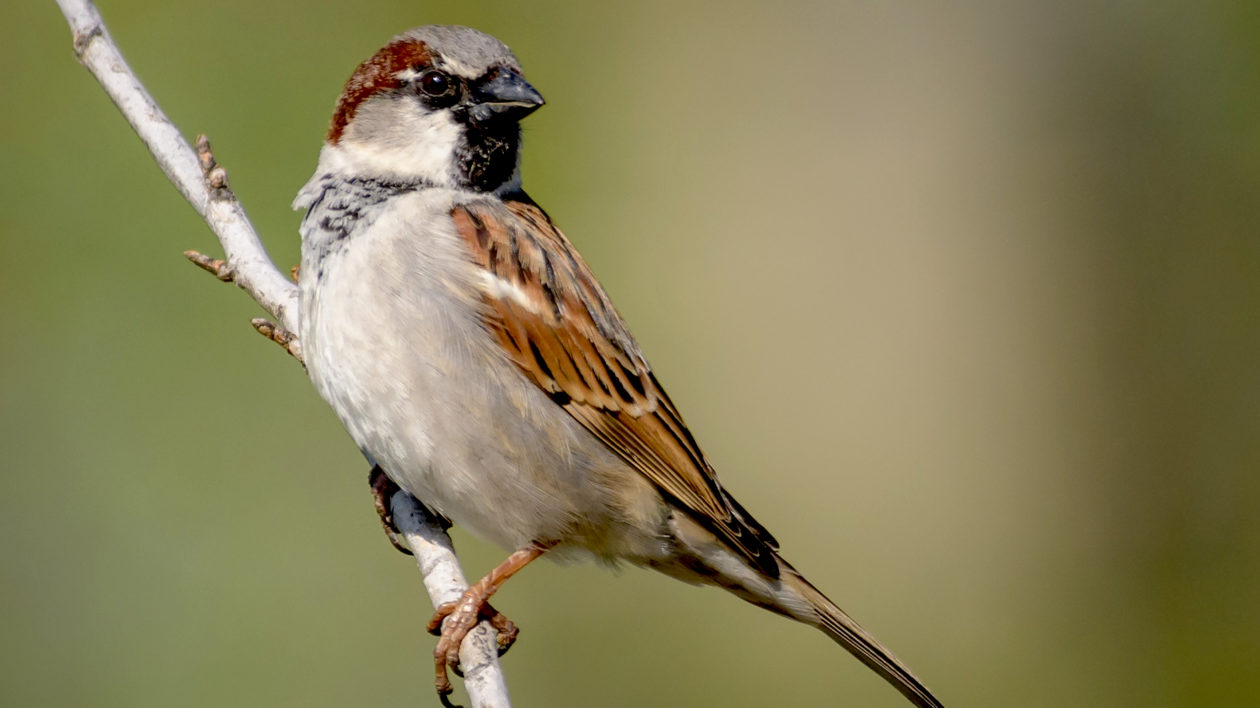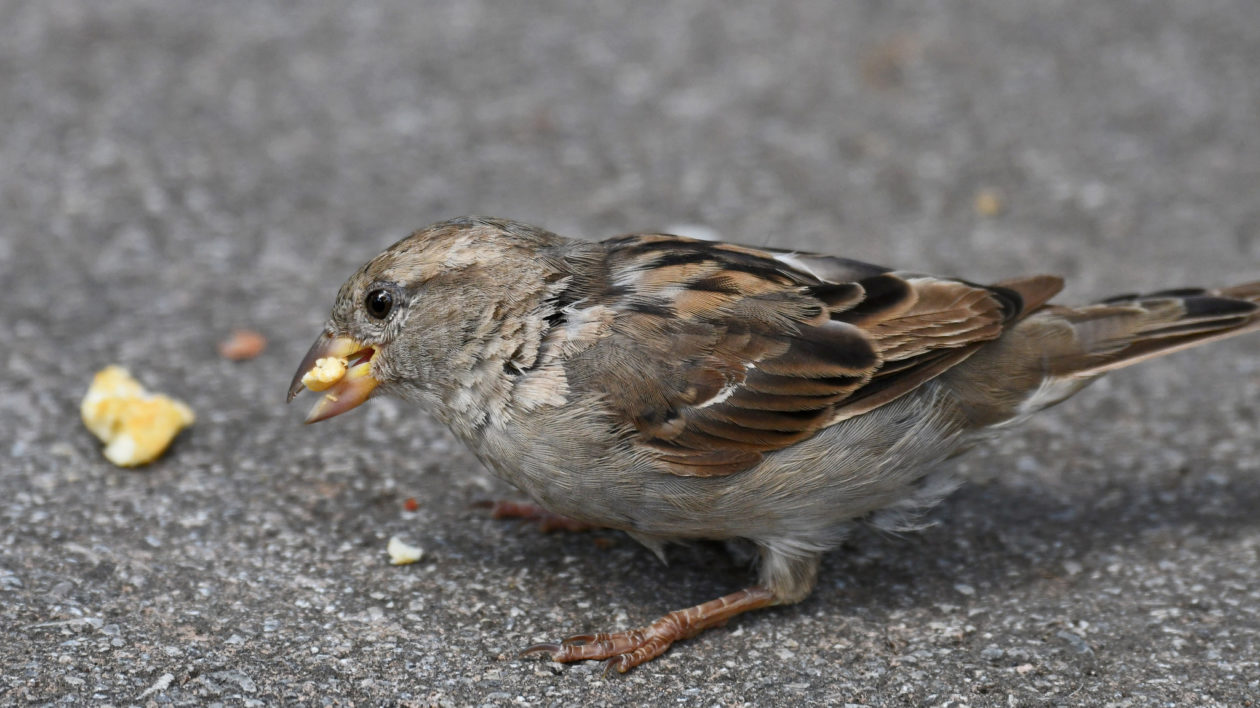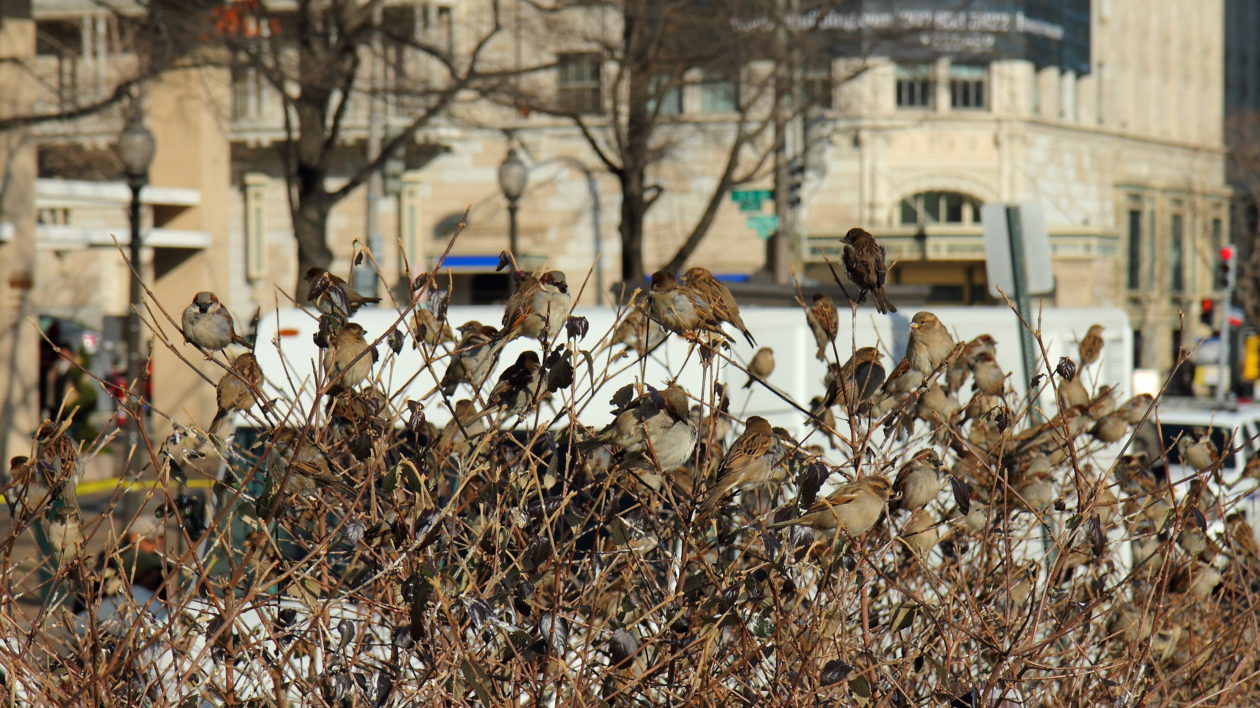I look out my window, and they’re everywhere: hundreds of house sparrows flit around our shrubs, hop around the yard, and steal food from our backyard chickens.
At this time of year, the males puff up and display, making them appear like much larger birds. They cheep incessantly, often drowning out other birdsong.
Given their constant presence, it seems odd to be writing this: House sparrow populations have been declining worldwide, including in their native range.
House sparrows are often considered one of the most adaptable birds, capable of thriving amongst our farms, suburbs and cities. The real story of their spread and decline is a bit more complex, and may have implications for urban conservation.
The Sparrow Fad
The house sparrow (Passer domesticus) is native to Eurasia, but beginning in the mid-1800s, it spread around the globe. Largely due to intentional releases by humans, house sparrows are now found on every continent except Antarctica, as well as many islands. It is the most widespread wild bird on earth.
As with many aspects of conservation history, many of the details of sparrow introductions are poorly documented. The first introduction to North America was to New York City in 1851 or 1852, although the 8 pairs released seemed to fare poorly. However, this set off a wave of introductions throughout the United States.
For a time, some sources refer to a “sparrow fad,” with private individuals breeding birds, and others catching them and releasing them into new areas. Nest boxes were installed in cities to increase sparrow populations. Ornithologists and others raised concerns over the merits of house sparrows, but their arguments proved futile against sparrow enthusiasts releasing cages full of birds.
The reason for many of these reasons was for pest control. For instance, their 1868 introduction to Philadelphia was apparently an effort to control inchworms. As with so many such pest control efforts, the cure proved worse than the disease. They thrive on a variety of foods, including spilled grain and even garbage.
The house sparrow is also an aggressive little bird. It nests in cavities, and pushed out native species like Eastern bluebirds. Backyard birders who erect birdhouses have undoubtedly noticed house sparrows bullying wrens and other native species.
Public sentiment turned quickly against the house sparrow. By the 1880s, just three decades after the first introduction, several U.S. cities paid bounties for the birds. But by then the bird was firmly established – and spreading.

Recent research published in the Proceedings of the Royal Society B found that house sparrows underwent genetic changes, including modified skull development and a gene that helps create the enzyme amylase that helps break down starch. The researchers hypothesized that these changes helped sparrows adapt to human settlements dominated by agricultural fields and livestock. The sparrows, according to the research, diverged from other Old World sparrows around 11,000 years ago, just as agriculture was taking hold in the Middle East.
The house sparrow appears to be a clear winner in the Anthropocene: an adaptable bird capable of thriving equally well on cities and in farms.
But over the past few decades, ornithologists have noted a new trend: house sparrows are in widespread decline. According to the Cornell Lab of Ornithology, house sparrow numbers in North America have declined by 84 percent since 1966. In Philadelphia, the city where the sparrows were introduced to control inchworms, the birds have largely disappeared.
Many birders view this as a good-news story. After all, house sparrows compete with native species and are generally viewed as a pest. However, the bird is experiencing similar declines in many parts of its native habitat, including the United Kingdom and Western Europe.
In England, house sparrow populations have declined by half. The species is listed by the Royal Society for the Protection of Birds as a species of high conservation concern. While the United Kingdom population has recently stabilized, the bird remains of concern to conservationists. European countries now recognize a World Sparrow Day to raise awareness of the plight of this once-abundant species.
What happened?

Sparrow Falling
Theories abound as to why house sparrows have declined. The answer likely lies in a combination of factors, all tied to rapid changes in both cities and farms. House sparrows may be highly adaptable, but that doesn’t mean they can thrive with every modification humans make to the environment.
The first house sparrow decline was actually reported in the 1920s, when automobiles began widely replacing horses. Sparrows feasted on the huge amount of spilled grain found in cities. When that food source was removed, sparrow populations decreased.
The Royal Society for the Protection of Birds and others note that changing agricultural practices likely play a significant role in the current sparrow decline. Once, farms were diverse, with crop fields and livestock barns scattered across the landscape. New, clean, intensified monocultures result in less spilled grain, and less cover around fields. In many parts of the world, other birds associated with farmland are also in decline.
Livestock is more frequently raised in confined operations, sometimes even indoors. All this results in fewer opportunities to feed on grain.
Similarly, city sanitary practices have improved, which may make finding meals more difficult for sparrows.
Research published in the journal Frontiers in Ecology and Evolution found that a combination of poor diet and air pollution induced physical stress on house sparrows, leading to reduced reproductive success.
The widely reported global insect decline may also be a significant factor. Many think of house sparrows as vegetarians, gobbling bird seed and grains. But, as with many birds, they rely on protein-rich insects to feed their young.

Implications for Urban Conservation
There are still 540 million house sparrows flying around the planet, so this bird is not in danger of going extinct. It’s still abundant in many places – including my neighborhood, where a mix of native vegetation, bird feeders and backyard chicken coops provide the diversity of habitat and food sources that enables these birds to thrive.
So why is the house sparrow decline important?
In part, it shows how little we understand urban ecology. Even conservationists often assume that common, adaptable species will be able to adapt to any change. That’s clearly not the case.
All ecosystems change, but human environments often change rapidly. If we’re thinking about protecting biodiversity in cities – and in a world that will have 9 billion people, we have to – we have to think about how changes impact wildlife. Just as modification to a tropical forest affects wildlife, so too do changes in farming practices, changes in city design, even changes in bird feeding habits.
I wouldn’t miss the house sparrow from my neighborhood. It’s an invasive species that competes with native birds. But globally, the sparrow’s decline is a story we should heed, as it may help us better understand how to coexist with nature in the Anthropocene.




We have many house and other sparrows that live in areas around the Dallas metroplex. Of course, most people in my neighborhood have bird feeders . We also have blue jays, cardinals, several kinds of the titmouse, wood peckers, an occasional mockingbird, and many, many doves that come to feed and use the bird baths.
I live in Queensland Australia and I remember as a child that house sparrows were everywhere, we used to trap them in the chicken runs. I now live in an outer suburb of Brisbane and have not seen a house Sparrow for years. I am wondering if the introduction of the Indian Minor has driven them out, or worse, killed them off.
There is a lot of bush land where I live now. I can’t see any reason why they have disappeared.
Interesting discussion. My central New Jersey backyard’s Blue Bird and Tree Swallow populations were displaced by House Sparrows about 15 years ago, with the House Sparrows thriving ever since. This year I have noticed for the first time that nesting boxes are empty and HS sightings are rare, while other sparrow and finch pops seem normal.
Sparrows Have Disappeared
The sparrows have disappeared completely from the cities at least four years ago in Britain, as mobile phones grew in popularity. Third generation (3G) mobile phones were introduced in 2003, and there were over 65 million users in the UK by the end of 2005, more phones than people (ISIS 2007)
Scientists at the Research Institute for Nature and Forests in Brussels, Belgium, have produced the first evidence that mobile phone base stations are affecting the reproductive behaviour of wild sparrows. This finding comes as mobile phones are held suspect in the massive collapse of bee colonies all over the United States and Europe. Fewer house sparrow males were seen at locations within relatively high electric field strengths of GSM base stations (ISIS 2007)
https://stop5g.cz/en/wildlife-studies-phones-vanishing-birds/
Last year here in the Denver area there were hundreds of sparrows at my feeder and bird bath, I haven’t seen one yet this year. we’ve had a couple snow / freezes after a couple of false starts of spring. Of course course I don’t know if that’s part of the problem or not. No Sparrows. It’s just weird.
We only have a few kinds of birds around here. Eastern Jays , Robins, finches, crows, seagulls, geese, Prairie falcons and doves. once a year in the spring I see a small red headed woodpecker and an occasional nuthatch, thats it.
Its a bird desert!
I wonder if the prairie hawk scared them out of this area, but i haven’t seen him or her yet either.
Last year here in the Denver area there were hundreds of sparrows at my feeder and bird bath, I haven’t seen one yet this year. we’ve had a couple snow / freezes after a couple of false starts of spring. Of course course I don’t know if that’s part of the problem or not. No Sparrows. It’s just weird.
We only have a few kinds of birds around here. Eastern Jays , Robins, finches, crows, seagulls, geese, Prairie falcons and doves. once a year in the spring I see a small red headed woodpecker and an occasional nuthatch, thats it.
Its a bird desert!
In my years with the Christmas bird count in Denver I have also noticed a decline in house sparrows. Not sure yet if I am sad about that. I have also noticed a decline in American robin numbers the past couple of years.
I love house sparrows and miss them. Back in the 1990s we had huge flocks in the neighborhood. Now, not so much.
I have seen declining numbers over the past three years, however some days I am inundated and they are feisty. Two days in a row I have seen both male and female House sparrows feeding their young. This is a moderate size city suburb in the southeast. They may be somewhat bothersome, but starlings……..
In Oaxaca city, Mexico, a long term monitoring shows a decline of 40%. There is no reason of change of agriculture, building or others facts. The unique reason I found so far, it is a increase of parasites eating the keratine of the legs. As cavity nesters, the option of nesting is low and obligatory the same. So may be a reason.
I still have to toss out house (English)sparrow eggs from my blue bird nests. Upstate New York
We have had house sparrows for a long time. They nest above our outdoor speakers and thoroughly enjoy their cozy spot. Needless to say, we don’t play music on it, while they are in residence. We live above a canyon with full views of the ocean .
House sparrows do not SEEM to be in decline here in the Mid-Willamette Valley of Oregon. Is there data from here that supports a decline? I find that house sparrows will utilize the various sized and styled wooden bird houses that are being distributed here in our area intended for many different species by the Yamhill County Soil and Water Conservation District, with only swallows being a species that likes to use them as designed and intended.
I wonder if farmers planting seeds treated with insectisides might be killing birds. I live in a rural area and I have noticed crop fields are completely void of bees and butterflys. Farmers used to have bee boxes for pollination but I seldom see them now.